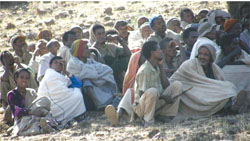40.3.3 Analysing public health data by person, place and time
The distribution of a disease can be described by recording which person was affected (who), the place where the case occurred (where) and the time when it occured (when). Information about the person affected should include their age, sex, ethnic group, religion, occupation and marital status (Figure 40.2). Place of illness may be household, kebele or woreda. Time of illness can be recorded as a day, week, month or year.

Can you describe the distribution of malaria and pneumonia in Table 40.1 by the age of the patients (compare those aged five years old or younger, with those aged over five years), and the sex of the patients? Express your answer in words and construct a table showing the distribution of cases based on their age and sex.
Three out of the four malaria cases occurred in patients above the age of five years; all three pneumonia cases occured among children under five years. Three out of four cases of malaria occured in females, while two out of three cases of pneumonia occured in males. Table 40.3 shows this distribution.
| Age/sex of patients | Malaria cases (4) | Pnuemonia cases (3) |
|---|---|---|
| Age | ||
| < = 5 years | 1 | 3 |
| > 5 years | 3 | 0 |
| Sex | ||
| male | 1 | 2 |
| female | 3 | 1 |
Footnotes
The symbol < = means ‘less than or equal to’. The symbol > means ‘greater than’40.3.2 Incidence rate
